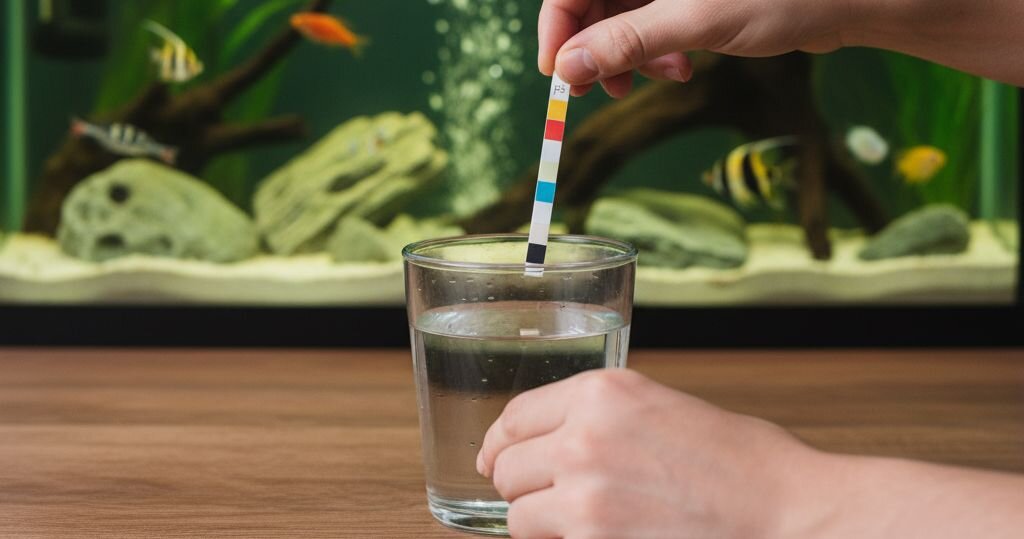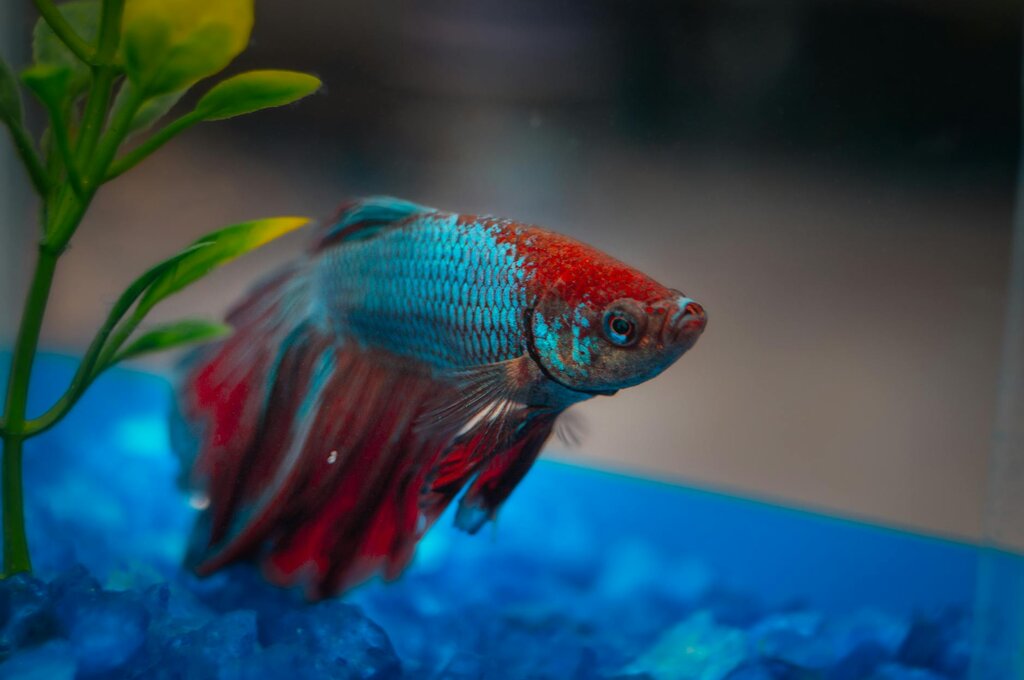Last Updated: 02/10/2025
How to Maintain a Healthy Fish Tank: A Vet's Guide
From testing water quality to general upkeep, our vet guide covers all the essentials of fish tank maintenance. Learn the simple steps to keep your fish happy, healthy, and thriving in a clean and safe environment.
Author: Dr Emilee Lay BVSc BSc (Vet) Hons
Reading Time: 10 minutes - short read
Keeping fish can be a wonderfully rewarding experience, bringing a calming slice of nature right into your home. But behind the serene beauty of a vibrant aquarium is a delicate ecosystem that needs a little help from you to thrive. Just like any other pet, your fish rely on you to provide a safe, clean, and healthy environment. A well-maintained tank is the cornerstone of happy, healthy fish.
It can seem daunting at first, with all the talk of pH levels, nitrogen cycles, and filter media, but don't worry! This guide is here to demystify the process. We'll swim you through the essentials of fish tank maintenance, from understanding the importance of water quality to establishing a simple, effective cleaning routine. With a little knowledge and consistent care, you can ensure your underwater friends flourish.
In this article
Water testing

Why regular water testing is key
Think of it as a regular health check-up for your tank's ecosystem. Testing your water at home helps you catch invisible problems, like a sudden ammonia or nitrite spike, before they can harm your fish. Since many fish diseases can be linked back to poor water quality, being proactive can save a lot of heartache.
Even with a powerful filter, you still need to do regular water changes - at least once a week, or more often for smaller tanks. This is vital for keeping your fish happy and healthy.
What you'll need
- Water testing kit
- A clean bucket (used only for your fish tank)
- Gravel siphon
- Water conditioner
- Fish net
- Biological filter additives (optional)
Understanding your water test results
Water tests measure the levels of specific chemicals in your aquarium. It's best to test at least once a week, before you do a water change. The main things to test for are:
Choosing a test kit
You have a few options when it comes to testing kits. Using a combination can make long-term maintenance much easier.
- Dropper Kits: These are the most accurate but can be a bit finicky to use.
- Dipstick Strips: These are very fast and convenient for a quick check.
- In-tank Testers: These monitors sit inside your tank and give you a constant reading of crucial levels like ammonia and pH.
For more information, read through our guide to Common Aquarium Problems.
Water quality and testing products
How to clean your tank

A regular cleaning routine is the secret to a healthy tank. Here's a step-by-step guide to doing it right.
Preparation:
- Wash your hands and arms thoroughly to remove any soaps, lotions, or oils before reaching into the tank.
- Turn off and unplug all equipment, including heaters and filters.
- Aim for a 20% water change each time. Larger changes (50% or more) can stress your fish and should only be done in emergencies, like an ammonia spike.
Cleaning the gravel and decor
A gravel vacuum is your best friend for siphoning up debris while removing old water.
- Push the vacuum into the gravel to suck up waste.
- Choose a vacuum that is long enough for the depth of your tank.
- Take out any decorations and give them a gentle scrub with a tank-safe brush to remove algae.
- You can leave your fish in the tank during a routine clean. If you're doing a major overhaul, you can temporarily move them to a bucket of their original tank water.
Cleaning the filter
Your filter is home to millions of beneficial bacteria that are essential for your tank's health. Cleaning it correctly is vital.
- Vet Tip: Never wash your filter media with tap water! The chlorine will kill all the good bacteria, forcing your tank's ecosystem to start from scratch.
- Place some of the old tank water you've siphoned into a bucket.
- Gently rinse the filter sponges and media in this bucket of old tank water to remove gunk without harming the bacteria.
- Use a tube brush to clear any algae from the filter's tubing to ensure good water flow.
- You may only need to clean your filter once a month or every couple of months, depending on how many fish you have.
For more information, read through our Fish Filter Guide.
Cleaning the aquarium glass
Don't forget the glass itself! Algae and mineral deposits can build up over time.
- Use an aquarium-specific sponge or scraper to clean the inside surfaces.
- Be careful: If you have an acrylic tank (which is less common), use an acrylic-safe sponge to avoid scratches. Scratches not only look bad but can also trap harmful bacteria.
- Magnetic glass cleaners are a great tool for a quick clean in between major water changes.
Adding fresh water to your aquarium
The final step is to refill the tank safely.
- Treat the new water: Before adding it to the tank, treat your fresh tap water with a water conditioner. Important: Dose the conditioner for the total volume of your tank, not just the new water you're adding. Wait 20-30 minutes for it to work.
- Add beneficial bacteria: This is a great time to add a biological booster to help maintain your tank's healthy cycle.
- Check the temperature: If you have a tropical tank, make sure the new water is roughly the same temperature as the tank water. A sudden temperature drop can shock your fish.
- Refill slowly: Pour the new water in gently to avoid stirring up the substrate and stressing your fish. Pouring it over a decoration or using a small jug can help.
Setting up a tank for the first time? Check out our Guide to Setting up your Tank, and How to Cycle Your Fish Tank.
Tank cleaning supplies
FAQs
While it might seem like a lot to remember, maintaining a healthy fish tank is all about creating a simple, consistent routine. By regularly testing your water, performing weekly partial water changes, and cleaning your equipment the right way, you provide the stable and thriving environment your fish need.
This proactive approach is the best way to prevent common health problems and ensure your aquatic pets live long, happy lives. With a little practice, these steps will become second nature, allowing you to spend less time worrying and more time enjoying the beauty of your underwater world.
Articles recommended for you
Our vet authored guide to the benefits of feeding your dog fresh food plus tips and advice for introducing it into their regular menu.
See our guide to protecting your pet from parasites from our vet team.
Thinking of getting a fish? Check out our guide for setting up a tank and home care tips!
Looking to understand horse feeds better? This comprehensive guide covers feeding recommendations for horses of all ages and disciplines.
Does your pet suffer from anxiety? Check out our Vet-guide for treatment options to help your pet.
History
Our experts continually monitor the health and wellness space and we update our articles when new information becomes available.
Thu 2 Oct 2025
Edited by Dr Gillian Hill BVSc (Hons)Dr Emilee Lay BVSc BSc (Vet) Hons
Veterinarian
Dr. Emilee graduated from the University of Sydney in 2018 with a Bachelor of Veterinary Science and Bachelor of Science (Veterinary Studies) and as a student worked for a number of years as a small animals and exotics nurse in clinics across Sydney. She is currently a practicing small animal and exotic vet along the Coast. Emilee holds a special passion for avian and exotic medicine (bunnies being her favourite patients), as well as animal behavioural medicine!

